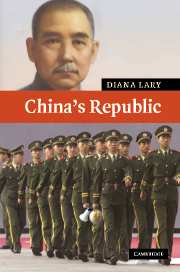Book contents
- Frontmatter
- Contents
- List of illustrations
- List of maps
- List of tables
- Acknowledgments
- Introduction
- 1 The decline of empire, the dream of a republic: 1890s–1911
- 2 The early Republic – chaos and creativity: 1912–28
- 3 The Nanjing decade – a new beginning? 1928–37
- 4 The Resistance War – warfare and chaos: 1937–45
- 5 The Civil War – the most vicious conflict: 1946–9
- 6 More than survival – the Republic on Taiwan: 1949 to the present
- Conclusion: the end of the Republic?
- Index of names
- Index of places
- Index of subjects
- References
1 - The decline of empire, the dream of a republic: 1890s–1911
Published online by Cambridge University Press: 05 June 2012
- Frontmatter
- Contents
- List of illustrations
- List of maps
- List of tables
- Acknowledgments
- Introduction
- 1 The decline of empire, the dream of a republic: 1890s–1911
- 2 The early Republic – chaos and creativity: 1912–28
- 3 The Nanjing decade – a new beginning? 1928–37
- 4 The Resistance War – warfare and chaos: 1937–45
- 5 The Civil War – the most vicious conflict: 1946–9
- 6 More than survival – the Republic on Taiwan: 1949 to the present
- Conclusion: the end of the Republic?
- Index of names
- Index of places
- Index of subjects
- References
Summary
China's imperial system lasted for more than two millennia, through twenty or more dynasties, some of which lasted only a few years, others several hundred. Between dynasties the empire was periodically disunited, sometimes for hundreds of years at a time, but – ultimately – strong, centralized rule was always restored under a new dynasty. It seemed inconceivable that the imperial system itself could come to an end. But the processes set in motion by a combination of Western incursion and internal rebellion and decay led to that shocking outcome, in 1911. The Manchu Qing dynasty turned out to be the last Chinese dynasty. The downhill path toward the collapse was painful for those who believed in the status quo, exhilarating for those who wanted to hasten its demise.
The downhill slide
The signs of decline
Foreign invasion, peasant rebellion, religious sectarianism, official corruption, a Yellow River flood – in traditional Chinese statecraft theories these were some of the unmistakable signs of dynastic decline, signs that the Mandate of Heaven was being withdrawn and the dynasty losing the right to rule.
Between the 1850s and the early 1890s the Qing dynasty experienced every one of these inauspicious events. The British, French, and Russians made substantial incursions into China, in a series of wars that ended in unequal treaties. There were rebellions throughout the country, some without obvious religious elements (the Nian), others driven by religious zeal. The largest of them, the Christian-influenced Taiping Rebellion (1851–64), took over almost half of China.
- Type
- Chapter
- Information
- China's Republic , pp. 14 - 44Publisher: Cambridge University PressPrint publication year: 2007

